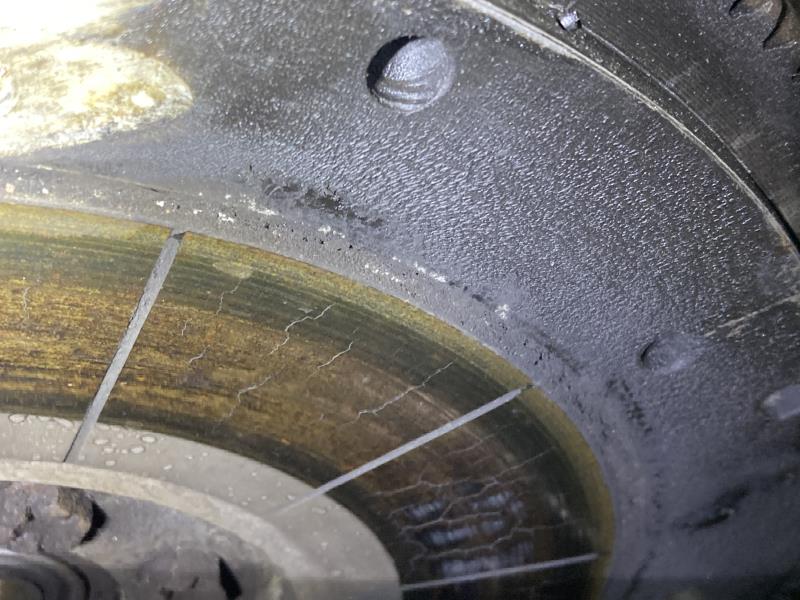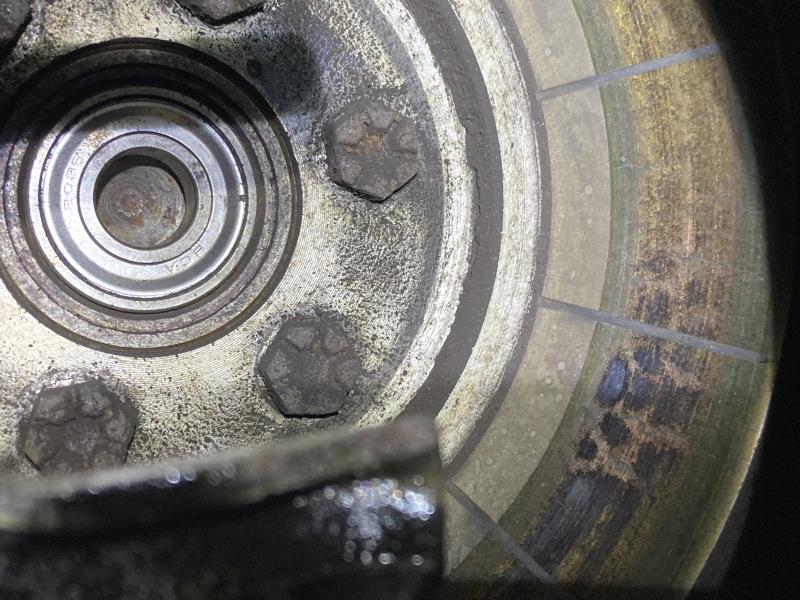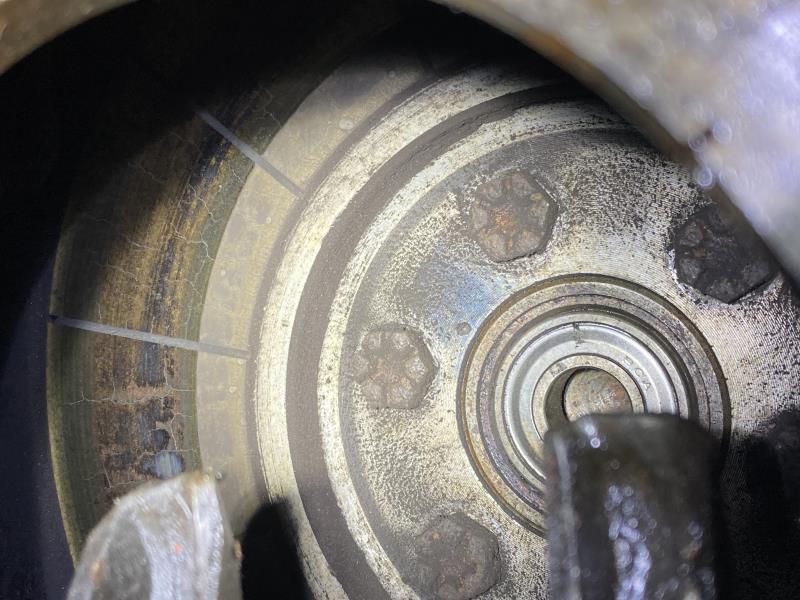|
By peeeot - 3 Years Ago
|
Around 2000 rpm the engine does not feel as smooth as it should. Power and responsiveness are good.
The flywheel is an aluminum Scheifer unit. I am suspicious that I am dealing with a flywheel balance issue, or perhaps pressure plate/clutch balance. The input seal to the transmission is leaking oil, so I am prepared to do a teardown, replace clutch components, and have the flywheel balanced (assuming it’s in good enough condition to do so)—but I want to make sure I have covered the other reasonable possibilities before diving in.
Any suggestions for what else I should check?
|
|
By Deyomatic - 3 Years Ago
|
|
I am not an expert by any means but whatever you do, when you have it all apart, if there is some way to evaluate the input shaft I would try to do that. I had to replace the tailshaft seal in my old '55 Fairlane..so I did. Then a few months later I got a NASTY vibration that turned out to be the driveshaft so I got a new one and the same yoke wouldn't fit anymore. Turned out the imbalance bent the tailshaft so I needed a different tranny...turned into a real rabbit hole situation.
|
|
By Ted - 3 Years Ago
|
Short of taking the flywheel and pressure plate to a shop to have the balance checked, you might try cranking the engine up with the transmission removed. Be sure the throw out bearing and arm are out of the way. With the pressure plate still bolted to the flywheel, just determine if the same imbalance is present or not. If the vibration is still present, then remove the pressure plate and clutch disk and run the engine again. If the vibration diminishes and/or is gone, you’ll know it’s the pressure plate/clutch disk assembly is at fault. If the vibration is still there, then it’s likely the flywheel. Be sure to have the pressure plate also balanced to the flywheel when getting any of the pieces checked at a balance shop.
|
|
By peeeot - 3 Years Ago
|
Ted, that is a great suggestion. If I end up removing the transmission I will certainly try it.
Today I had the car up on ramps and took another look at this vibration. I had noticed it around 1800-2000 rpm mostly while driving, but slowly increasing engine speed in neutral while stopped I found the vibration to be strongest at 1600. I tried disconnecting the vacuum advance to see if timing affected it and if so the effect was very minor.
Next I crawled under the car with it idling. I don’t have a flywheel dust cover, so I could easily observe the clutch assembly rotating. The flywheel itself appeared totally smooth with no runout or wobble evident at all at idle speed. The pressure plate housing was harder to be sure about because its shape is irregular. The element of the pressure plate that actually contacts the clutch disc did appear to be slightly non-concentric with the crank. I’m not sure if it was enough to produce my vibration.
The only other thing I can think of to check is running the engine with the belt removed to eliminate the fan, water pump, and alternator as potential causes—but I seriously doubt they are.
|
|
By DANIEL TINDER - 3 Years Ago
|
|
I WAS going to suggest checking the timing, as too much advance at that rpm could likely result in a subtle ‘rough running’ vibration (mine disappeared eventually as the points wore down). Lean fuel mixture might maybe also cause the same effect (?)
|
|
By peeeot - 3 Years Ago
|
Four months later, I finally got around to removing the transmission. So far, all I have tested is running the engine with the transmission removed. The imbalance is still evident (unchanged, I believe). I crawled up into the transmission tunnel with it running around 1600 rpm and didn't see anything irregular. Crank, pilot bushing, pressure plate fingers, flywheel all looked perfectly concentric and smooth-spinning.
Hopefully tomorrow I'll be able to remove the clutch/pressure plate and see what effect that has.
One other thing I found is that my transmission doesn't have an input seal. The one I bought is supposedly for a Warner T86, but I have the Ford transmission. I guess the gasket must be the leak point up front.
|
|
By 312YBlock - 3 Years Ago
|
|
Any chance at all for a simple miss fire. If your at a loss can’t hurt to check the plugs.
|
|
By Florida_Phil - 3 Years Ago
|
T86 transmissions do not have front input seals. My '55 TBird has it's original top load T86 three speed O/D transmission. When I purchased it, the transmission had a leak in the front which I concluded was the front input seal. After removing it, I discovered these transmissions do not have a seal on the input shaft. I called Van Pelt and he told me BW used a spiral grove cut in the input to channel fluid back into the case. After further inspection, I discovered a plug missing in the front of the transmission. I installed the correct plug, replaced the shifter arm seals and have no further leaks.
|
|
By Lord Gaga - 3 Years Ago
|
A lot of people including myself found out the hard way that those transmissions have no input shaft seal after parking their cars nose down on a steep hill and oiling up the clutch disc. Something to remember! peeeot (5/10/2022)
Four months later, I finally got around to removing the transmission. So far, all I have tested is running the engine with the transmission removed. The imbalance is still evident (unchanged, I believe). I crawled up into the transmission tunnel with it running around 1600 rpm and didn't see anything irregular. Crank, pilot bushing, pressure plate fingers, flywheel all looked perfectly concentric and smooth-spinning. Hopefully tomorrow I'll be able to remove the clutch/pressure plate and see what effect that has. One other thing I found is that my transmission doesn't have an input seal. The one I bought is supposedly for a Warner T86, but I have the Ford transmission. I guess the gasket must be the leak point up front.
|
|
By DryLakesRacer - 3 Years Ago
|
|
From the diagrams I’ve looked at the Ford transmission has an oil shield behind the front main bearing to defect most of the transmission oil into the case. Other transmissions don’t have them I’ve had apart. I’ve never had a standard transmission apart with a front seal. There has always been a drain back cast into the Throwout bearing snout and an opening in the front of the case. The gaskets have always been thin.
|
|
By peeeot - 3 Years Ago
|
Phil, mine is the same as yours with the spiral groove in the bearing retainer. The gasket is very thin and I suspect the surfaces weren’t perfectly clean when it was assembled last.
Good news! With the clutch off I believe the vibration is gone. That is to say, there is no noteworthy change in vibration as I move from 1000rpm up to 2000rpm. The clutch disc is pretty worn anyway so I’ll do the full job, get the assembly balanced, and get back to driving.
I am thinking I need a new flywheel though. Here are some pics of the Schiefer unit on the car. There are 3 hot-spotted areas evenly spaced. The friction surface is not perfectly flat either, with a lip at the perimeter. Can’t tell what it’s made of, but it looks almost like brass.   
This is a 10” clutch with 10 splines. Any leads on a good source for the flywheel and clutch kit? Opinions on going to diaphragm-style if available?
|
|
By FORD DEARBORN - 3 Years Ago
|
|
Years ago I purchased a flywheel from Mummert. It came drilled for the standard (long style) clutch and the diaphragm (Mustang) clutch. Not sure what's available now but a throwout bearing and hub was available too. Good luck...............
|
|
By peeeot - 3 Years Ago
|
I have a steel flywheel from a 223. It also has a 10” clutch and pressure plate, but came off a truck. This will work with a y-block too, right?
Any concerns using a 10” clutch with a 312? I’m not sure I can use the 11” because my transmission input shaft is 1-1/16” diameter.
|
|
By charliemccraney - 3 Years Ago
|
If a 10" clutch worked before then it will probably work again. Diameter is only one variable and a lot more goes into a clutch. 11" probably is "safer" in terms of working correctly for the application.
For a 1 1/16" x 10 spline and 11" diameter, 275 clutch kits:
https://www.summitracing.com/search/part-type/clutch-kits/disc-diameter-in/11-000-in/input-spline-quantity/10/input-shaft-diameter/1-063-in?SortBy=Default&SortOrder=Ascending
You will need to ensure that it will mount to the flywheel, or have the holes drilled and tapped.
I had troubles with a diaphragm clutch in my truck. I think the problem was due to the pressure plate being thinner, throwing the geometry of the clutch fork to throwout bearing interaction out of whack, which resulted in bearing collars wearing prematurely. With no easy way to try to correct that geometry, I simply converted to a hydraulic throwout bearing setup.
I don't know that it was the problem and it may not mean anything for yours, being a car, which uses a different fork and TO bearing arrangement.
|
|
By DryLakesRacer - 3 Years Ago
|
|
Not sure on the Ford collars diameter but for the, Muncie, BW T-10, Richmond, and Tex Racing transmissions I’ve used I have collected TO bearings with 3 depths. It has depended on which style pressure plate is used to determine the correct geometry. I have also added washers behind the screw-in pivot ball to adjust them.
|
|
By peeeot - 3 Years Ago
|
|
Correction: my input shaft is 1" diameter. I put a caliper on it to be sure. Looks like Vanpelt Sales might be my source.
|
|
By peeeot - 3 Years Ago
|
|
I ended up sourcing clutch parts from Van Pelt and using a steel flywheel I had from a 223. I had them balanced and am pleased to report clutch engagement and drivetrain are both silky smooth!
|
|
By DryLakesRacer - 3 Years Ago
|
|
That is great to hear. I’m guessing driving with a steel or cast iron flywheel Is more of a pleasure than the aluminum one. I’ve always liked a heavier flywheel on the street..
|
|
By peeeot - 3 Years Ago
|
|
Definitely. I can’t perceive the engine revving any more slowly either. It just feels like everything works more cohesively.
|
|
By peeeot - 3 Years Ago
|
Well, perhaps I posted too soon. Now that I have put some miles on the new clutch setup, I am finding that things often feel exactly as they did before. The intensity comes and goes, but it’s always the same sort of vibration or roughness and always in the same 1600-2000 rpm range.
Seems like I have ruled out a clutch or flywheel problem at this point. All the transmission bearings felt great. Motor mounts are new but not the “steady rest.” Also, the exhaust pipe is very close to the frame where it passes through on the passenger side. I’m hoping it’s just some kind of engine-to-frame contact.
|